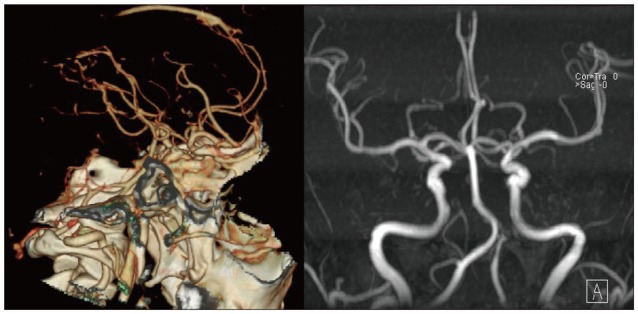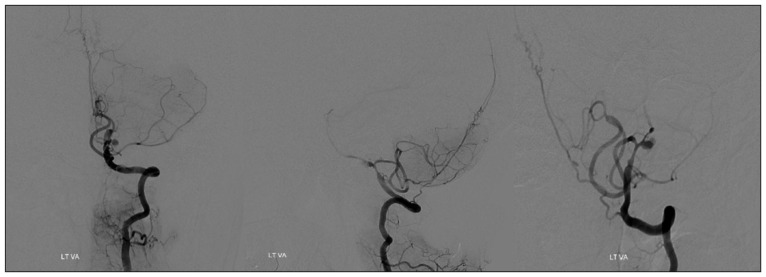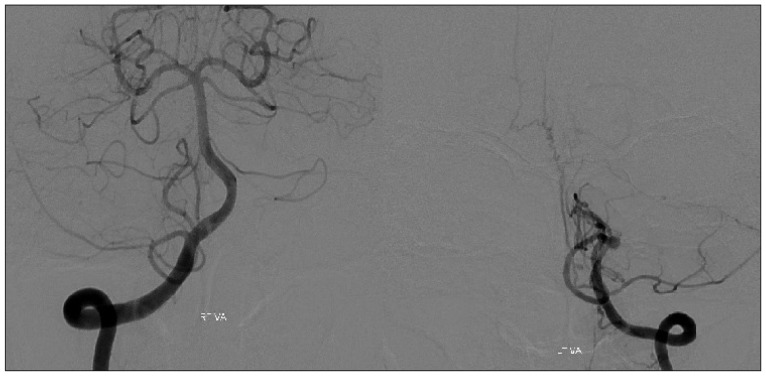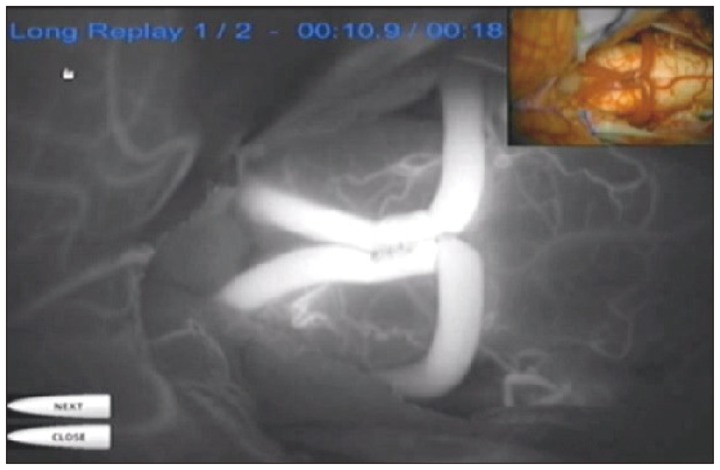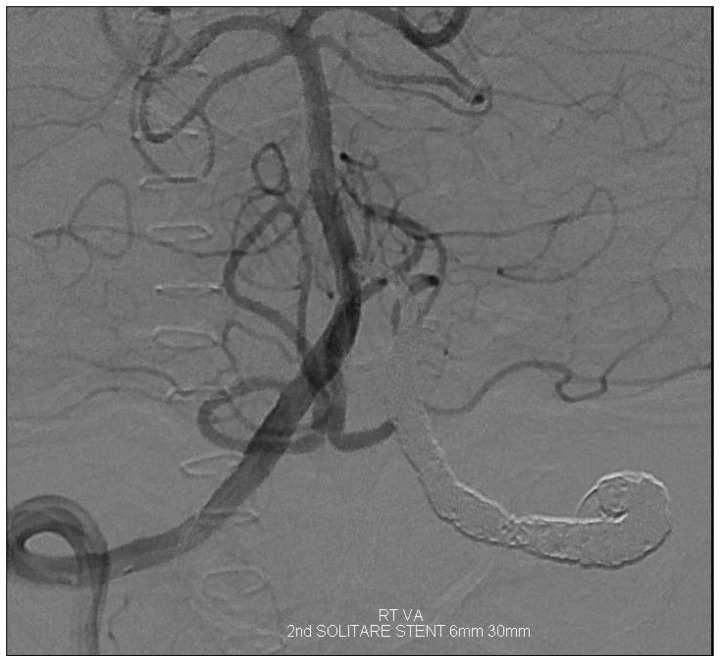J Korean Neurosurg Soc.
2014 Jan;55(1):36-39. 10.3340/jkns.2014.55.1.36.
A Case of Endovascular Treatment for Followed by Side to Side Bypass for Vertebral Artery Dissecting Aneurysms Involved Posterior Inferior Cerebellar Artery
- Affiliations
-
- 1Department of Neurosurgery, Eulji University Hospital, Daejeon, Korea. heeyah20@eulji.ac.kr
- KMID: 2191038
- DOI: http://doi.org/10.3340/jkns.2014.55.1.36
Abstract
- Treatment of complex aneurysms usually entails not only direct clipping but also alternative treatment modality. We recently experienced a case of vertebral artery dissecting aneurysm and obtained good treatment outcomes. Our case suggests that the endovascular segmental occlusion with posterior inferior cerebellar artery (PICA) to PICA side anastomosis might be a good treatment option in patients with complex vertebral artery dissecting aneurysms. A 45-year-old woman has a left vertebral dissecting aneurysm with dizziness. Based on the aneurysmal morphology and the involvement of PICA, the patient underwent side to side anastomosis of the PICA. This was followed by the endovascular segmental coil occlusion. The aneurysmal sac was completely obliterated. At a 2-year follow-up, the patient achieved a good patency of both PICA. In conclusion our case suggests that the endovascular segmental occlusion of the parent artery followed by PICA to PICA bypass surgery through a midline suboccipital approach is a reasonable multimodal treatment option in patients with complex vertebral artery dissecting aneurysms.
MeSH Terms
Figure
Cited by 1 articles
-
Endovascular Treatment of Vertebral Artery Dissecting Aneurysms That Cause Subarachnoid Hemorrhage : Consideration of Therapeutic Approaches Relevant to the Angioarchitecture
Seung Hoon Lim, Hee Sup Shin, Seung Hwan Lee, Jun Seok Koh
J Korean Neurosurg Soc. 2015;58(3):175-183. doi: 10.3340/jkns.2015.58.3.175.
Reference
-
1. Hacein-Bey L, Connolly ES Jr, Mayer SA, Young WL, Pile-Spellman J, Solomon RA. Complex intracranial aneurysms : combined operative and endovascular approaches. Neurosurgery. 1998; 43:1304–1312. discussion 1312-1313. PMID: 9848843.
Article2. Hoh BL, Putman CM, Budzik RF, Carter BS, Ogilvy CS. Combined surgical and endovascular techniques of flow alteration to treat fusiform and complex wide-necked intracranial aneurysms that are unsuitable for clipping or coil embolization. J Neurosurg. 2001; 95:24–35. PMID: 11453395.
Article3. Jamieson KG. Aneurysms of the vertebrobasilar system; surgical intervention in 19 cases. J Neurosurg. 1964; 21:781–797. PMID: 14210010.4. Kumar CR, Vannemreddy P, Nanda A. Far-lateral approach for lower basilar artery aneurysms. Skull Base. 2009; 19:141–149. PMID: 19721770.
Article5. Kwon M, Lee JH, Kim JS. Dysphagia in unilateral medullary infarction : lateral vs medial lesions. Neurology. 2005; 65:714–718. PMID: 16157904.
Article6. Lewis SB, Chang DJ, Peace DA, Lafrentz PJ, Day AL. Distal posterior inferior cerebellar artery aneurysms : clinical features and management. J Neurosurg. 2002; 97:756–766. PMID: 12405360.
Article7. Pisapia JM, Walcott BP, Nahed BV, Kahle KT, Ogilvy CS. Cerebral revascularization for the treatment of complex intracranial aneurysms of the posterior circulation : microsurgical anatomy, techniques and outcomes. J Neurointerv Surg. 2011; 3:249–254. PMID: 21990836.
Article8. Redekop G, TerBrugge K, Willinsky R. Subarachnoid hemorrhage from vertebrobasilar dissecting aneurysm treated with staged bilateral vertebral artery occlusion : the importance of early follow-up angiography : technical case report. Neurosurgery. 1999; 45:1258–1262. discussion 1262-1263. PMID: 10549948.9. Tang ZW, Shi XE, Zhang YL, Zhou ZQ. [Surgical treatment of vertebral artery-posterior inferior cerebellar artery dissecting aneurysms]. Zhonghua Wai Ke Za Zhi. 2010; 48:1805–1810. PMID: 21211386.
- Full Text Links
- Actions
-
Cited
- CITED
-
- Close
- Share
- Similar articles
-
- Dissecting Aneurysm Associated with a Double Origin of the Posterior Inferior Cerebellar Artery Causing Subarachnoid Hemorrhage
- The Dissecting Aneurysm of the Posterior Inferior Cerebellar Artery with Unusual Clinical Course
- Simultaneous Vertebral Artery Dissection and Contralateral Posterior Inferior Cerebellar Artery Dissecting Aneurysm
- Stent-Jack Technique for Ruptured Vertebral Artery Dissecting Aneurysm Involving the Origin of Posterior Inferior Cerebellar Artery
- In Situ Intersegmental Anastomosis within a Single Artery for Treatment of an Aneurysm at the Posterior Inferior Cerebellar Artery: Closing Omega Bypass

